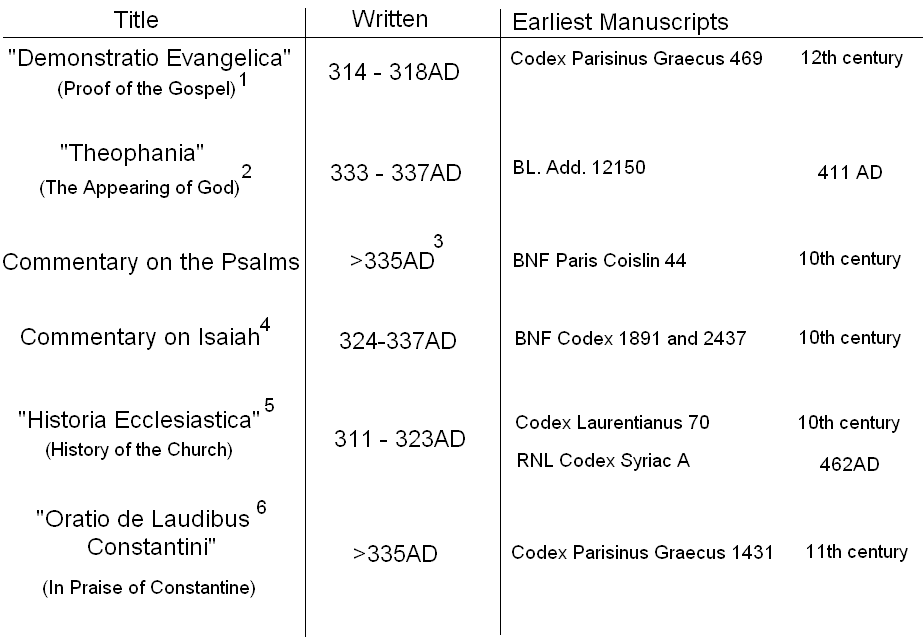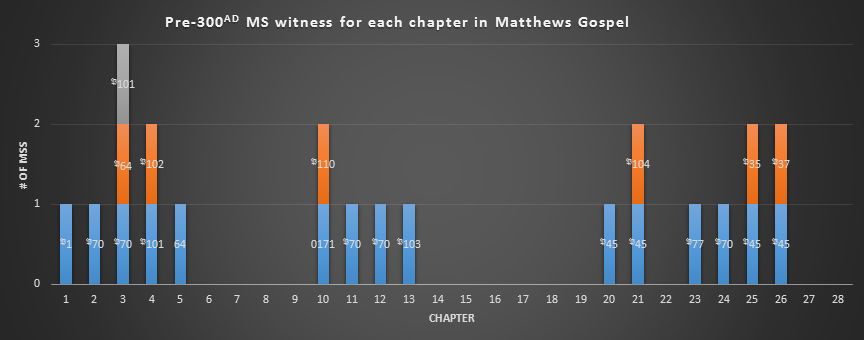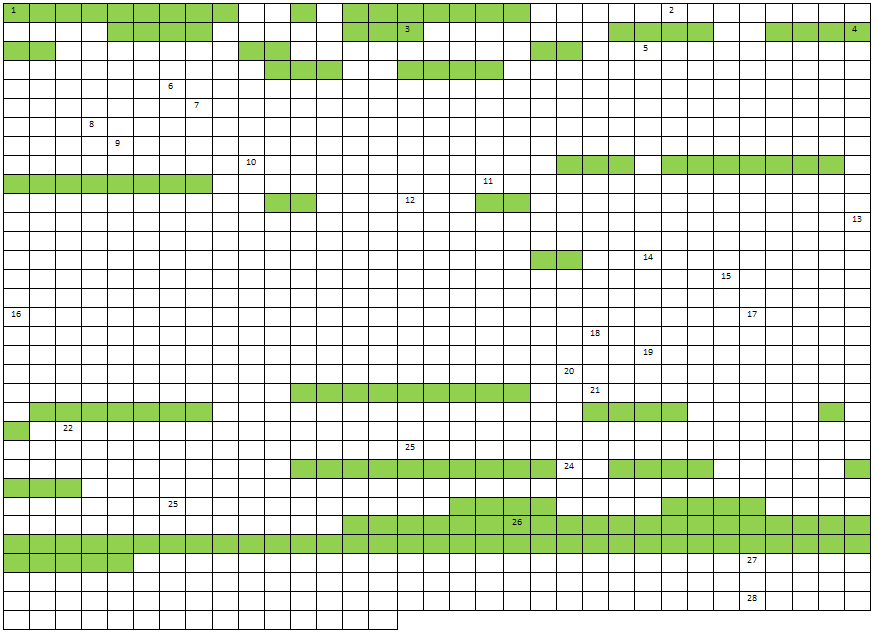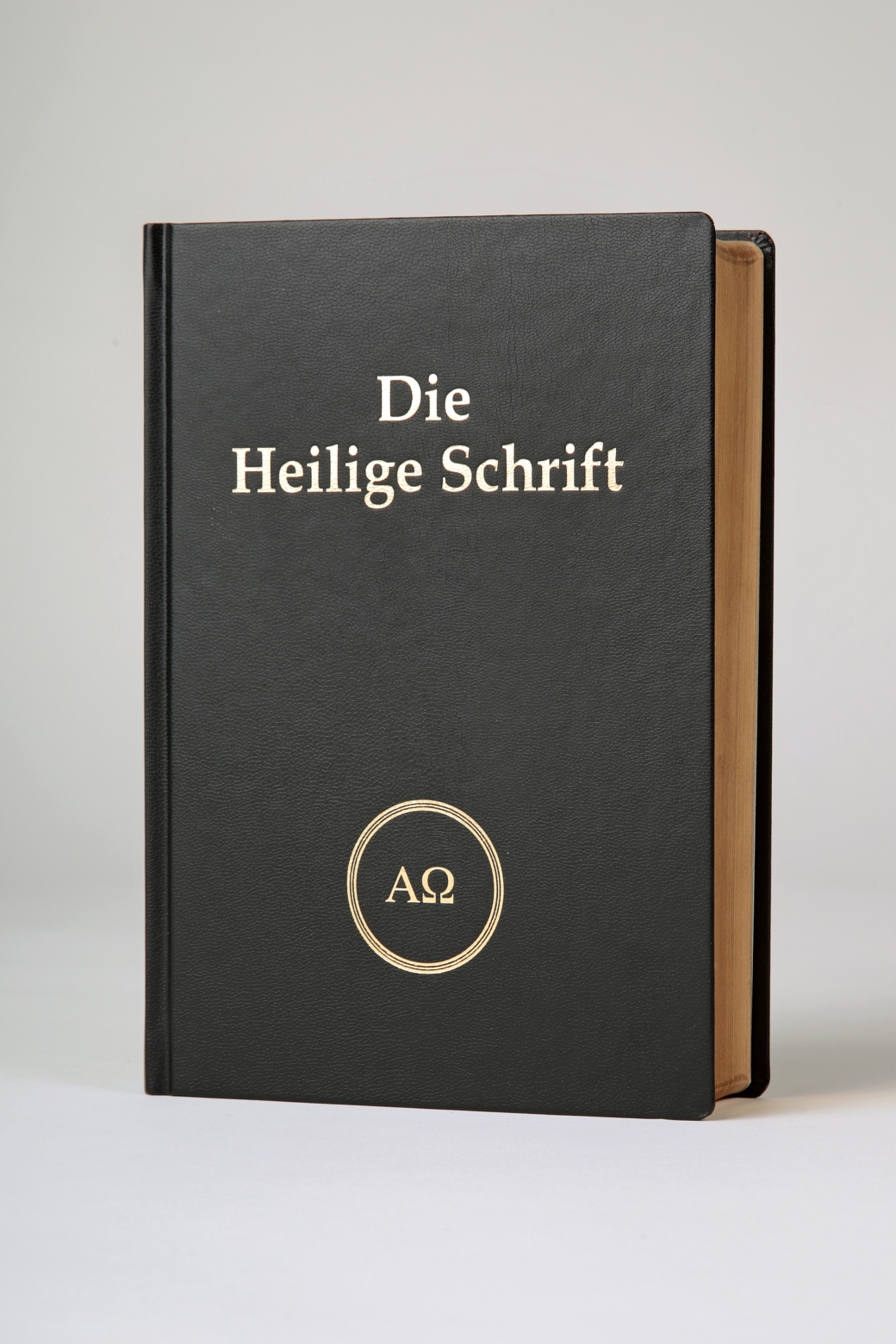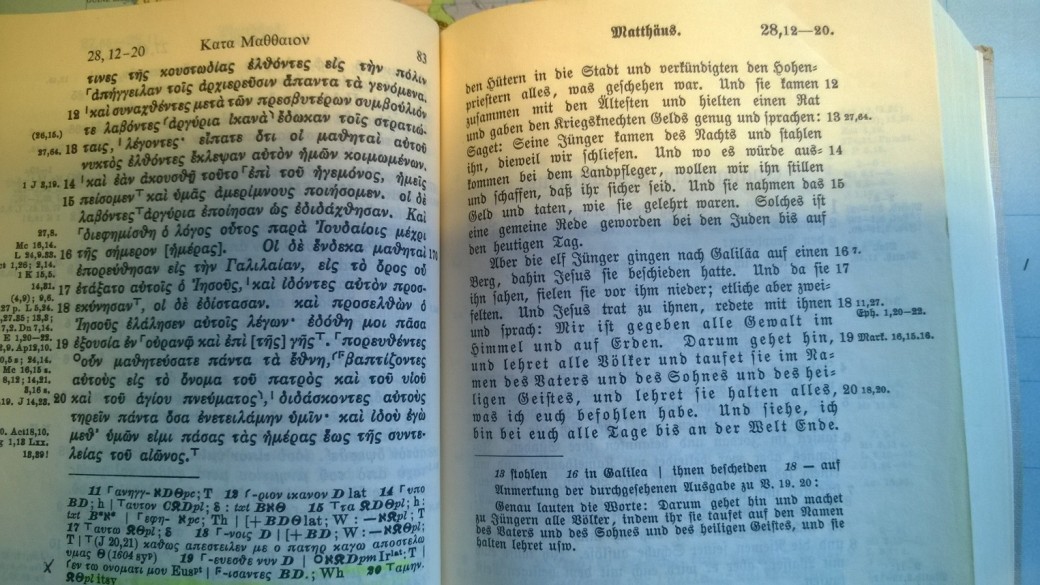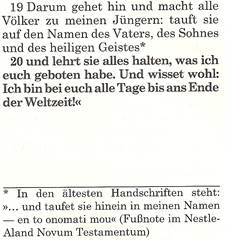After it was found that Mr Ewald Frank, leader of the Freie Volksmission (FVM), seemed to have published several inaccurate statements regarding the text of Matthew 28:19, and to have done so repeatedly over many years, contacting him directly to discuss the matter was the next logical step.
It is much to Mr Frank’s credit that he took the time to respond to my emails despite his no doubt busy schedule. I am most grateful for his taking the time to provide the image from his 1973 Nestle Aland. Unfortunately he has not at this time granted permission to reproduce the content of his emails on this website. This is a great pity, as what he had to say was very interesting for a number of reasons. In the absence of an actual quotation, i will summarize the content of his replies paying very careful attention to express his meaning with accuracy, sentence by sentence. My emails will be posted in full.
It is somewhat ironic that Mr Frank withheld permission to publish his emails due to concerns of being misquoted. As the request was to publish his emails in their entirety, that would obviously not have been possible. Now that summaries are all that can be placed online, that may raise suspicions of misquotation after all…..
I humbly ask that i be trusted as a Christian brother to honestly handle his words. It would be definitely preferable to me if all the emails could simply be made available. If there are any doubts, then you are encouraged to write Mr Frank yourself and see if you receive a similarly worded reply .
My 1st email
This was sent to the FVM through their contact form found here
To: ******@freie-volksmission.de 05/08/16
Name: man
Vorname: james
E-Mail:
Betreff: Kontaktformularübermittlung: Variant reading at Matthew 28:19
Nachricht:Hopefully you are well as you see this message.
(A few days ago I sent this same message directly to this email address, but it occurred to me that it may have been filtered to your junk mail. Please forgive the second sending!)
Recently I have had a chance to look through a Bible that was produced by the Free Peoples Mission, and noticed an interesting textual variant noted for Matthew 28:19, on page 55 in the NT portion of course.
I was wondering if you might provide me with your source material for the variant, if you would have time to do so. It would be especially useful to have a scanned image/digital photograph of the Nestle Aland edition that is referred to, as my edition does not contain such a variant reading.
Also, since this is an edition of the Bible that your organization put together, would it be possible to see your sources for saying that the “oldest manuscripts” contain the reading “and baptize them into my name”?
The only possible source for the variant I have found from my own looking is a few quotations from the writings of Eusebius of Caesarea, and non of the oldest manuscripts that contain his writings are from before the 5th century – Codex Siniaticus predates that significantly, and it contains the usual reading of Matthew 28:19.
I thank you for reading, and hope to hear from you on this matter.
Yours faithfully in Christ Jesus our Lord,
Mr Frank’s 1st reply
On the 8th of August 2016 Mr Frank replied. There was attached the sought after Nestle Aland image.
I am greeted as a fellow member in Christ’s family.
Mr Frank apologized for his delay in replying (though it was only a few days since my first email was sent. He clearly values emails, and strives to keep timely responses.) He mentions a weekend meeting he had been overseeing at the Freie Volksmission home base in Krefeld, Germany. Over one thousand people had come to the meeting from diverse parts of the world.
The attached photograph of the NA was referred to, and i was directed to give particular attention to the “en to onomati mou” located in the apparatus. This, Mr Frank said, matches how baptisms in the book of Acts were carried out.
Mr Frank invites me to look at other, unnamed, biblically grounded publications on the subject, which are presumably made available by the FVM.
After expressing a desire to be able to assist in this matter, Mr Frank graciously signs off.
My 2nd email
Von: <>
Datum: Dienstag, 9. August 2016 um 01:15
An:
Betreff: RE: Matthew 28:19
Dear Mr Frank,Please receive my thanks for sending along the photograph. Your time must certainly be at a premium, particularly on the weekends.
This weekend i also managed to look at a copy of the 21st edition of the NA, given to me by a local pastor, and it has the exact same textual data as yours, whatever edition that may be.
Consulting the apparatus information in the front of the book there is a section on how to read the various symbols used to indicate variants in the text.
Looking at that has led me to some confusion that perhaps you can help with…
The footnote on page 55 of the FVM Bible at Matthew 28:19 seems to say that the Nestle Aland supports a reading of “and baptizing them in My Name”.
But the Nestle Aland apparatus indicates that the phrase “en to onomati mou” should replace everything after the word “ethne” (peoples/nations), as shown by the symbols that bracket the text from before “baptizontes” until after “pnumatos”.In that case, we would have a reading of “make disciples of all nations in My Name”.
This matches the quotes from the writings of Eusebius found in Patristic sources.In addition to that, i am still not clear on which manuscripts are being referred to where the FVM Bible footnote states that “the oldest manuscripts say”.
It would be of great use to learn which manuscripts are being referenced, so please do forgive my persistence in asking you again.
Many thanks for replying – it is surely easy to ignore emails when you are busy, but you have chosen not to do so and that is appreciated.
Yours in Christ Alone,
Mr Frank’s 2nd reply
In this email, on the 10th of August 2016, i am again greeted as though a family member in Christ.
Mr Frank seeks to make it clear that he cannot possibly locate the source material for the “oldest manuscript” statement made in the FVM Bible, as his library contains too many books.
It is recommended that i use the internet and physical history books, and that there i am sure to find the answers.
Expressing a desire to be truthful, Mr Frank reminded me that we should place no particular value upon what the Nestle Aland or the writings of Eusebius might have to say. We have, he went on to say, more than enough evidence from various cited texts in the book of Acts and Romans to know how the early church understood Matthew 28:19. They had a God given understanding of what that text meant.
Mr Frank assures that he has done everything possible to aid in making this all clear to me, and that it is only within the power of the Lord Jesus to do more.
Mr Frank again signs off with a blessing.
My 3rd email
Von:
Datum: Donnerstag, 11. August 2016 um 23:59
An: Betreff:
RE: Matthew 28:19Dear Mr Frank,
Thank you again for your continued response.
Please understand that it was not my intention to trouble you with discussion on the meaning of Matthew 28:19 or the other scriptures you referenced in your last reply.
You have published many works on that subject and we need not go into it again here I agree.I also would not have thought to impose upon you to do research that you are correct in saying that it is my responsibility to do.
What brought me to write to you was the researching I had done already of the statements made in the previously referenced textual footnote at Matthew 28:19 on page 55 of the Bible produced by the free people’s mission.
I could find no support for saying that “the oldest manuscripts” include the text “and baptize them in my name”: the oldest complete copy of Matthew, codex sinaiticus, contains the usual text. As does every other ancient copy containing that verse.
The writings of Eusebius, though some were written before codex Sinaiticus, have no physical manuscripts dating from before that codex.The reference to the Nestle aland text in the footnote also confused me. The footnote seemed to be saying the NA supported the reading of “baptize in my name”, but upon consulting that book, it does not in fact appear to do so.
Researching these things was the reason I felt it necessary to contact you: what I have found so far, without exception, disagrees with the footnote in the Bible, and it was hoped that you might be able to bring forth support for that footnote.
Please do not think of me as being impatient on this matter. I appreciate the many demands on your time and do not presume to rush you for answers.
If you do not wish to continue this communication I will respect your wishes of course.
I shall still remain thankful for your interaction so far.
Apologies for the length of this message.
respectfully
Mr Frank’s 3rd reply
15th August 2016
Greeting me once again as member of Christ’s Church in a familial sense, Mr Frank expresses gratitude over the fact of our communication. The necessity of his being needed by other people of God’s household explains the brevity of the current email.
Mr Frank explains quickly that the FVMB footnote is outside his area of responsibility, and implies that some other writer should be held accountable. He expresses great thankfulness for what the Bible says about the issue of baptism, stating that what is contained therein is sufficient for him in all ways.
As previously, a gracious signing off.
My 4th email
From: james man
Sent: 15 August 2016 18:48:37
To: E. FrankDear Mr Frank,
I do appreciate the demands on your time and will respect your desire to conclude our communication on this subject.
Please forgive my last, and slightly longer, message to you on this matter….
From what you have said i can only understand that there is no evidence for the statements which have been at the center of our emails. (footnote at matt 28:19, p55 FVM bible)
It also appears that you are admitting this when you say that you are “NOT PERMITTED TO PUBLISH BY MR FRANK”. I’m not sure how else to understand your meaning…
Of course i would not say that you are responsible for anything, for example, one of your members happens to say in their personal capacity, but since this textual/manuscript claim is found in a bible produced by an organization that you are the visible leader of, it would seem reasonable for you to have some responsibility to what is said within it.
I might add that the same claim is also made in “The Bible – the Most Read Book on Earth” on page 24 in the German edition, page 22 for the English:
“The Critical history of the church has proven that the original version of the great commission in Mt 28:19 states as follows : “go ye therefore, and teach all nations, baptising them into my name (onto onomati mou), Teaching them to observe all things whatsoever i have commanded you…” That is how it is recorded in the footnote of the “Novum Testamentum Graece et germanice” published by Nestle-Aland, 1973 edition.”
These claims (and others on that same page 22) have formed the subject of our emails and there has been no supporting evidence provided to substantiate them.
I have provided some evidence and reason questioning the statements, but these have not been interacted with.This is a great pity, and i am sorry it has gone this way.
In light of this, i would beg your permission to reproduce the content of our email communication for a wider audience.
Having had the claims above mentioned to me by friends and family who follow your teaching, i feel an obligation to help them, in however small a way, to have a more accurate understanding in this regard.
Beyond these immediate relatives, it would also be instructive to include our conversation within an internet page covering the issue.I would quote you in full without alteration or abridgement, and will strive sincerely to uphold a respectful and honest tone throughout. You will have first reading of anything in which i quote you, with an open offer for you to suggest changes or offer response.
And please understand that i do not do this to attack you personally. That is very far from my intentions and heart in the matter. It is my conviction that all of us who call on the name of Christ, who is the Truth (Ps 51:6 Jn 14:6 et al), have a duty to be truthful in all things, no matter how small and no matter if we disagree with what is said or who says it.
Thank you once again for choosing to respond to my emails. It is to your credit that you have not simply ignored them, as is so easily done when it comes to digital letter writing.For this, and for you as an elder in general, you have my respect and Christian Love.
Yours faithfully
Mr Frank’s 4th reply
16th August 2016
Greeted once more as one sharing the same father, Ephesians 1:2 is paraphrased.
After assurance that my last email was looked at, i am asked to respect Mr Frank’s position as being only that of a preacher of the Word. Mr Frank states that it is not possible for him to communicate in this manner any longer.
In response to my request for permission to use our email conversation on paper or online, Mr Frank instructs me to only quote from his already published works, and not from our emails. He says that any one reading the quotations i might make of his words would not be able to know the context, and could therefore be left with a false impression.
Praying that God would bless me, Mr Frank signs off.
My 5th email
Re: FW: Matthew 28:19
James man
Fri 19/08/2016 00:30
To: E. Frank <e****@freie-volksmission.de>;
Dear Mr Frank,Thank you for always responding, it is very appreciated.
I certainly do respect your position as a pastor of many people. That is why i sought your help with this question.
I’m sure you would agree that a pastor should teach the truth and be prepared to defend those things he has said if questioned?It is a shame that you do not want others to read the contents of our emails, as i think it would be instructive in many ways.
I will do as you said, and not quote these emails, even in part, though i am legally permitted to do so according to “Fair use ” or, here in Canada, “Fair Dealing” laws.Please note however that i wanted to avoid the partial quotation practice you referred to by showing the whole content of our discussion in entirety – by doing that, there would be no chance that someone would misunderstand your words.
You have called me Brother throughout this conversation, and i assure you that i would not betray your regard for me as a brother in Christ by stooping to that level of dishonesty. As one saved by Christ’s love and Mercy, i stand before Him in all things and cannot abide such practices.
It was hoped that this could be presented in a totally open and honest way….In closing for this time, please accept my thanks for making the effort to write back, and especially for the photograph of your Nestle Aland.
In the spirit of openness, i will be sure to send you links to anything i personally write about this subject where your words are being referred to, either from our emails (though they will not be quoted) or from your printed materials. There will always be an open door for you to respond to anything said therein.
If you should choose to respond in that context, let it be understood that those emails will be published for the benefit of the discussion and its readers.My thanks to you once again
May the Good Shepherd of our souls led you in truth, and give you peace.
There was no response to this last email.
Summary
- Requests were made to Mr Ewald Frank of the Freie Volksmission, Krefeld, Germany, for supporting documentation/references regarding a footnote in a Bible produced by that organization.
- A digital photograph of two pages from a 1973 Greek/German Nestle Aland 25th edition showing Matthew 28:19 and apparatus was sent back in reply.
- Far from lending support to the claims made in the footnote, the Nestle Aland was found to provide evidence against the reading of Matthew 28:19 offered in the footnote.
- Having this pointed out to him, Mr Frank attempted to shift focus away from the question of manuscript evidence (external evidence) and on to exegetical evidence (internal evidence).
- He did this even though the whole point of the footnote in the FVMB is that it uses supposed manuscript evidence as support for its claims.
- All efforts to gain interaction on the understanding of the Nestle Aland failed, and, at one point, both the NA and Eusebius were dismissed as unimportant anyway.
- When pressed a little on the claim that the “oldest manuscripts” contain the preferred shorter reading, Mr Frank excused himself from providing any supporting references, even going so far as to lay responsibility for the footnote on someone else.
- Having said all he could, it was clearly stated that, in order to understand and accept the claims made in the footnote of the FVMB, a direct revelation would be needed on my part.
- Permission to quote from Mr Frank’s emails was denied
- In short, not one point of the questions made against the manuscript claims made by the FVM regarding Matthew 28:19 were responded to with any evidence.
It must of course be reiterated that Mr Frank is a busy man and may not have the time to spend on chasing up documentation requests. That is to be appreciated and understood. It must also be again mentioned that Mr Frank’s prompt, and kindly, replies despite his busy schedule impressed me and were very appreciated. His dedication to being available to anyone who might write to him is exemplary, and sets a high standard for all those in Christian ministry.
